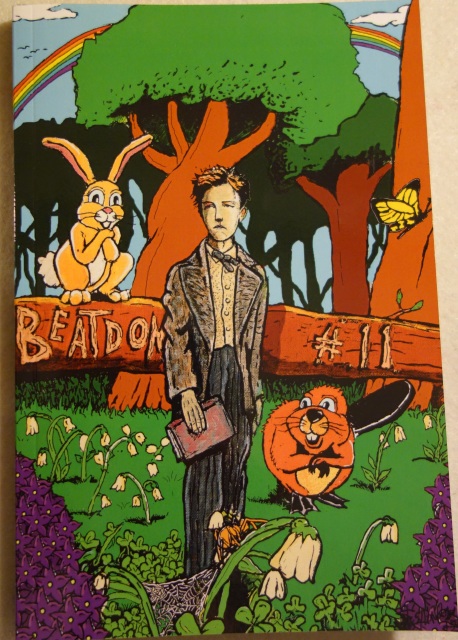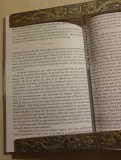- Featured Products
- >
- PRINTED MATERIAL
- >
- BEATDOM #11: The Nature Issue
BEATDOM #11: The Nature Issue
SKU:
€9.00
9
19
€9.00 - €19.00
Unavailable
per item
Contains Zeena's autobiographical story: Liberation Under the Snow Moon:
“Zeena's moving autobiographical account of her animal activism work with the rescue of 80 wolves from an Hungarian fur farm. Includes illustrations from Zeena's personal archives.”
- Beatdom
Publisher's description:
This is Beatdom's nature issue, exploring the relationship between the Beat Generation and the natural world. We have four huge interviews: Ann Charters, Al Hinkle, Richie Ramone, and Hank Williams III. There are essays on Hunter S. Thompson, Arthur Rimbaud, William S. Burroughs, and William Blake, and we welcome back Zeena Schreck, Katy Gurin, and Waylon Bacon.
Excerpt from 'Liberation Under the Snow Moon' below.
Paperback: 126 pages
“Zeena's moving autobiographical account of her animal activism work with the rescue of 80 wolves from an Hungarian fur farm. Includes illustrations from Zeena's personal archives.”
- Beatdom
Publisher's description:
This is Beatdom's nature issue, exploring the relationship between the Beat Generation and the natural world. We have four huge interviews: Ann Charters, Al Hinkle, Richie Ramone, and Hank Williams III. There are essays on Hunter S. Thompson, Arthur Rimbaud, William S. Burroughs, and William Blake, and we welcome back Zeena Schreck, Katy Gurin, and Waylon Bacon.
Excerpt from 'Liberation Under the Snow Moon' below.
Paperback: 126 pages
Beatdom Nature Issue #11 - 'Liberation under the Snow Moon'
EXCERPT:
"The wolves were captured at two months of age in April of the previous year (1990) as a result of a debt that couldn’t be paid. Originally, before the fall of the Iron Curtain, the owner of the fur farm had been head of a newly privatized tractor manufacturer. Now open for business in the free market, he’d filled an order to an old ally in Mongolia, equally ill-equipped for a market economy. The order placed for eighty tractors went unpaid. When the tractor company demanded payment, the Mongolian counterpart confessed there were no funds at all to cover the open bill. Instead, they had another enterprise, that of furriers. They could offer to send eighty wolf whelps in barter for the eighty tractors.
In order to obtain eighty whelps, all the adult wolves of the packs needed to be killed. There are normally five to eight wolves to a pack, so an estimated 100 to 400 wolves would have been killed to begin the breeding farm. The distribution of this wolf breed ranges from the northern mountains of Mongolia along the border of Russia all the way south to the Korean peninsula.
It should go without saying that a tractor manufacturer likely knows nothing of how to raise wolves. But the tractor company had no choice but to accept the unusual payment and began raising the wolves to be bred and slaughtered for their fur. Pairs of wolves lived lined up in two-square-meter cages. The proprietor assumed the cramped quarters would force them to breed.
After so many months in captivity under the conditions they were living, releasing them back in the wild would have meant certain death. But these wolves were blessed to have patron saints guiding them to their refuge nestled within the “Valley of Hell” or Vallée d’Enfer at the Parc à Loups du Gévaudan wolf sanctuary with funding from the Brigitte Bardot Foundation. Parc à Loups du Gévaudan wolf sanctuary’s name is inspired by La Bèstia de Gavaudan, a local werewolf legend that remains fresh in the minds of the French residents, as the French state has notoriously always given monetary rewards for the killing of wolves. It should be noted, as with so many legends and popularly accepted truths created out of political motivation: There, in fact, is no evidence that the hundreds of murders historically attributed to the werewolves of Gévaudan were actually caused by wolves. As with all witchhunts, the endless battle against ignorance requires one to always keep an open mind and sharp wits when considering such rumors - especially the rumors we choose to enjoy.
Despite the Parc à Loups du Gévaudan’s efforts to educate and rehabilitate the wolf’s public image, discrimination dies hard for those who’ve always suffered unwarranted persecution. Even today, the sanctuary suffers the hysteria and fear from some of the surrounding towns that one would expect in the Middle Ages. Fears from the locals that one day the evil monsters will break loose, metamorphosizing into blood-thirsty werewolves again, hunting the throats of the pious townspeople; so deep is the visceral human need to stamp out that "evil other".
Parc à Loups du Gévaudan provided the new refugees with eighty-five hectares of protected solitude and wild land to live in as close to their wild conditions as possible. In 1994, as a result of the expansion of the original eighty wolves into new wolf packs, forty of the original eighty Mongolian wolves were moved to an annexed park in St Lucia. The new twenty-hectare sanctuary was made exclusively for the descendants of the original Mongolian wolf rescue mission. Visitors can now observe them from a glass enclosed, elevated platform that doesn’t interfere in the wolves’ habitat. In their native land Mongolia, they’re not protected and the government still offers incentives for their kill.
One of the drivers of the three rescue trucks was also an employee at the former tractor-company-turned-fur-farm. He had cared for the wolves since their arrival in Hungary and had grown close to them. Because he knew how to drive the large semi-trucks, and because he knew the wolves since they were small, he offered to help pack the wolves into the transport cartons and drive them without payment, leaving his life behind. When we asked him what his plan was once he got to the destination, he simply raised his hands.
By the time we were finished feeding, watering, and medicating the wolves it was 3am, the wolf’s hour. We had four hours to sleep before seeing the wolves off the next morning.
Walking back to the Tiergarten at daybreak, another vulture sentinel perched on a fence post with a pony. A small gathering of journalists came to cover the story in Salzburg. More reported it in France, where Brigitte Bardot met the new arrivals at the nature preserve. [...]”
[Conclusion and full story in Beatdom #11 Nature Issue]
--Zeena Schreck, Liberation under the Snow Moon
Notes:
Parc à Loups du Gévaudan wolf sanctuary (French-language): http://www.loupsdugevaudan.com/les-loups/loups-de-mongolie/
Photos of the Mongolian wolves and their descendants by a visitor to Parc à Loups du Gévaudan wolf sanctuary with commentary posted to his blog: http://www.dogbreedinfo.com/animals/wolfpark.htm
EXCERPT:
"The wolves were captured at two months of age in April of the previous year (1990) as a result of a debt that couldn’t be paid. Originally, before the fall of the Iron Curtain, the owner of the fur farm had been head of a newly privatized tractor manufacturer. Now open for business in the free market, he’d filled an order to an old ally in Mongolia, equally ill-equipped for a market economy. The order placed for eighty tractors went unpaid. When the tractor company demanded payment, the Mongolian counterpart confessed there were no funds at all to cover the open bill. Instead, they had another enterprise, that of furriers. They could offer to send eighty wolf whelps in barter for the eighty tractors.
In order to obtain eighty whelps, all the adult wolves of the packs needed to be killed. There are normally five to eight wolves to a pack, so an estimated 100 to 400 wolves would have been killed to begin the breeding farm. The distribution of this wolf breed ranges from the northern mountains of Mongolia along the border of Russia all the way south to the Korean peninsula.
It should go without saying that a tractor manufacturer likely knows nothing of how to raise wolves. But the tractor company had no choice but to accept the unusual payment and began raising the wolves to be bred and slaughtered for their fur. Pairs of wolves lived lined up in two-square-meter cages. The proprietor assumed the cramped quarters would force them to breed.
After so many months in captivity under the conditions they were living, releasing them back in the wild would have meant certain death. But these wolves were blessed to have patron saints guiding them to their refuge nestled within the “Valley of Hell” or Vallée d’Enfer at the Parc à Loups du Gévaudan wolf sanctuary with funding from the Brigitte Bardot Foundation. Parc à Loups du Gévaudan wolf sanctuary’s name is inspired by La Bèstia de Gavaudan, a local werewolf legend that remains fresh in the minds of the French residents, as the French state has notoriously always given monetary rewards for the killing of wolves. It should be noted, as with so many legends and popularly accepted truths created out of political motivation: There, in fact, is no evidence that the hundreds of murders historically attributed to the werewolves of Gévaudan were actually caused by wolves. As with all witchhunts, the endless battle against ignorance requires one to always keep an open mind and sharp wits when considering such rumors - especially the rumors we choose to enjoy.
Despite the Parc à Loups du Gévaudan’s efforts to educate and rehabilitate the wolf’s public image, discrimination dies hard for those who’ve always suffered unwarranted persecution. Even today, the sanctuary suffers the hysteria and fear from some of the surrounding towns that one would expect in the Middle Ages. Fears from the locals that one day the evil monsters will break loose, metamorphosizing into blood-thirsty werewolves again, hunting the throats of the pious townspeople; so deep is the visceral human need to stamp out that "evil other".
Parc à Loups du Gévaudan provided the new refugees with eighty-five hectares of protected solitude and wild land to live in as close to their wild conditions as possible. In 1994, as a result of the expansion of the original eighty wolves into new wolf packs, forty of the original eighty Mongolian wolves were moved to an annexed park in St Lucia. The new twenty-hectare sanctuary was made exclusively for the descendants of the original Mongolian wolf rescue mission. Visitors can now observe them from a glass enclosed, elevated platform that doesn’t interfere in the wolves’ habitat. In their native land Mongolia, they’re not protected and the government still offers incentives for their kill.
One of the drivers of the three rescue trucks was also an employee at the former tractor-company-turned-fur-farm. He had cared for the wolves since their arrival in Hungary and had grown close to them. Because he knew how to drive the large semi-trucks, and because he knew the wolves since they were small, he offered to help pack the wolves into the transport cartons and drive them without payment, leaving his life behind. When we asked him what his plan was once he got to the destination, he simply raised his hands.
By the time we were finished feeding, watering, and medicating the wolves it was 3am, the wolf’s hour. We had four hours to sleep before seeing the wolves off the next morning.
Walking back to the Tiergarten at daybreak, another vulture sentinel perched on a fence post with a pony. A small gathering of journalists came to cover the story in Salzburg. More reported it in France, where Brigitte Bardot met the new arrivals at the nature preserve. [...]”
[Conclusion and full story in Beatdom #11 Nature Issue]
--Zeena Schreck, Liberation under the Snow Moon
Notes:
Parc à Loups du Gévaudan wolf sanctuary (French-language): http://www.loupsdugevaudan.com/les-loups/loups-de-mongolie/
Photos of the Mongolian wolves and their descendants by a visitor to Parc à Loups du Gévaudan wolf sanctuary with commentary posted to his blog: http://www.dogbreedinfo.com/animals/wolfpark.htm




